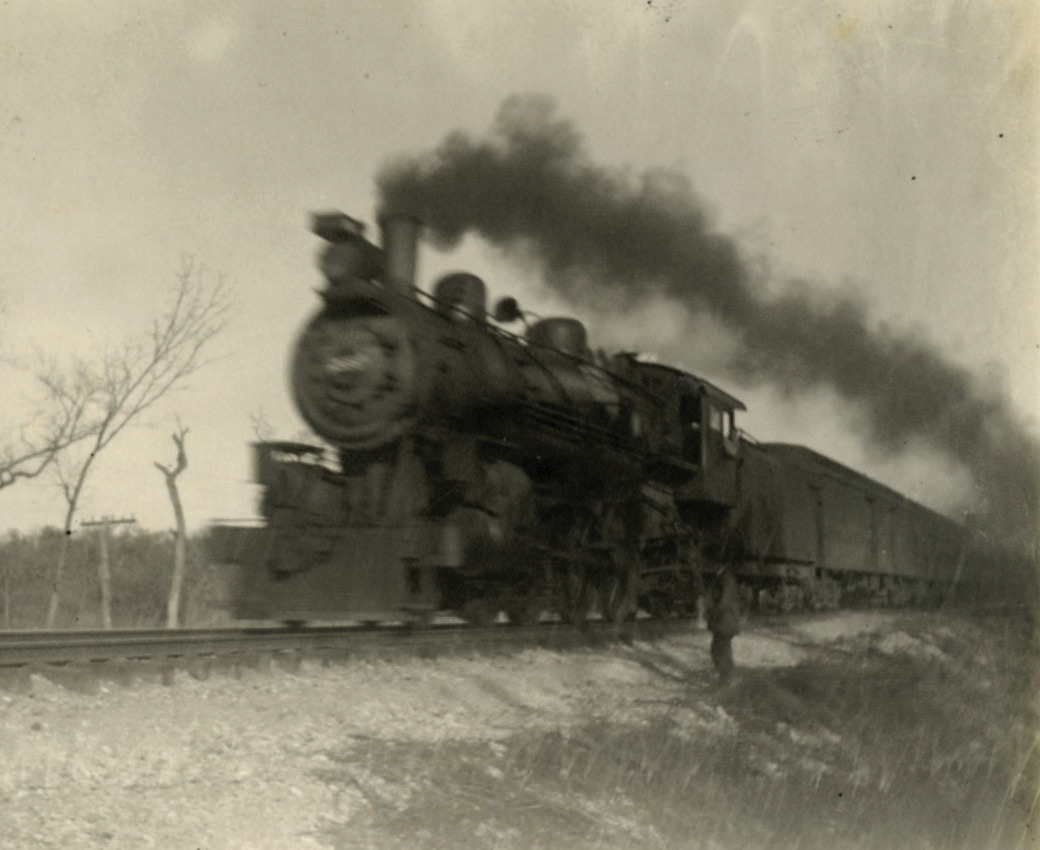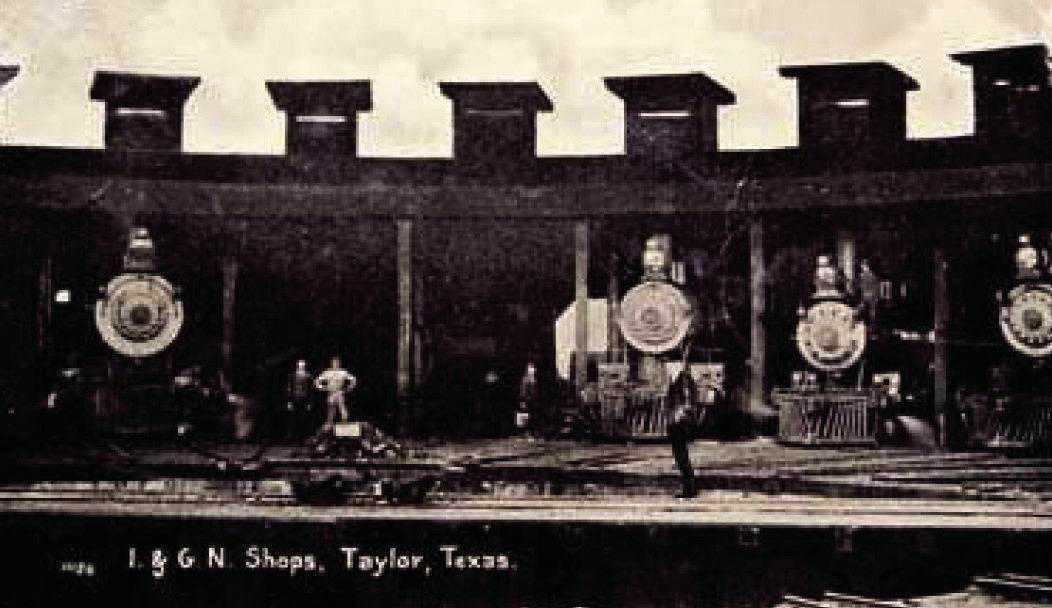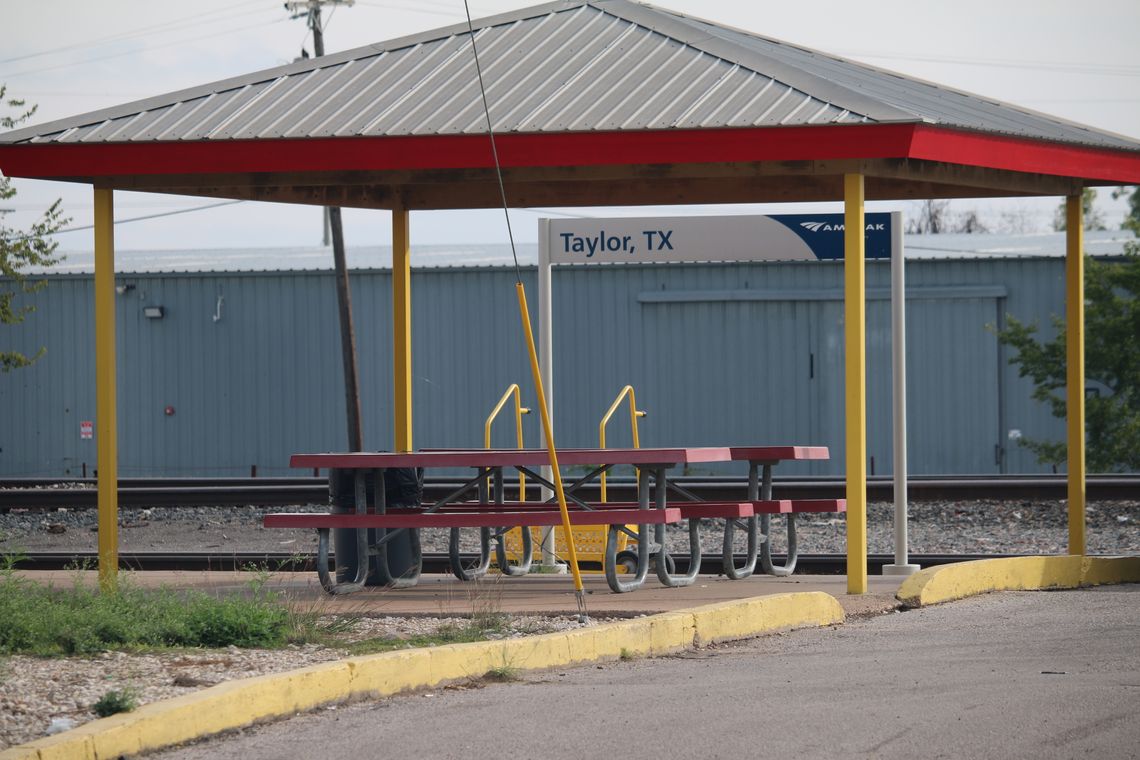TAYLOR — As the area’s high-tech industries grow and population swells, Taylor is dreaming big about improving its sole passenger rail stop for Amtrak to handle more arrivals and departures.
But for now, the dream hasn’t even left the station, though plans are picking up steam.
The stop at 118 E. First St. is one of only 19 passenger train stations still open in Texas and it is in desperate need of upgrading, city officials said.
The Amtrak Texas Eagle, with stops from Chicago to San Antonio, is the only passenger train using the Taylor stop and has just one arrival/departure per day, at 5:36 p.m.
“What we have is not considered an existing station. It is a single platform with no amenities whatsoever for a customer. You wouldn’t even know there was a station there. It’s paltry,” said Mayor Brandt Rydell.
The platform is nothing more than a metal canopy shading two picnic tables. According to Amtrak’s website, the company is planning to upgrade the platform for Americans with Disabilities Act compliance, but has not scheduled any expansion or other modernization.
”It’s the hope of the city to realize a full-fledged station in that area, but there are a number of players in the discussion, not least of which is Union Pacific, which owns most of the property in that area and controls the freight traffic through there,” Rydell said. “Getting Union Pacific to agree to certain improvements or changes can be a daunting task. But it’s not one we haven’t embarked upon; we have worked with them to try to realize the fullfledged vision.”
Union Pacific owns the tracks through Williamson County that Amtrak’s Texas Eagle line runs on. Around 14 freight trains travel the UP lines through Hutto and Taylor daily, along with the sole passenger train. Some concerns about UP’s willingness to cooperate stem from a failed attempt in 2015 to create a commuter rail line that was proposed to stretch from Austin to Georgetown with expansion into Hutto and Taylor.
The project, called the Lone Star Rail District, went off track in 2016 when UP withdrew from an agreement allowing LSRD to run on their rails. The project was revived earlier this year under the name RESTART Lone Star Rail District, with a petition to ask government officials to support a commuter rail line along the Interstate 35 corridor.
While a growing population, traffic congestion and climate concerns are acknowledged reasons to fast track passenger rail, the majority of the profits are in freight transport. Annually, freight rail moves about 325 million tons worth $405 billion through Texas train stations, according to the Texas Department of Transportation.
Amtrak counted 306,102 riders embarking and debarking in Texas in fiscal year 2022, with confirmed ticket revenue of $19,250,599 (not including the Fort Worth station, an additional estimated $10 million).
.JPG)
Georgetown Railroad Co. AWRR: Austin Western Railroad. Copyright 2023 Texas
Department of Transportation
Only 3,570 riders started or ended their journey at the Taylor station in FY 2022, with ticket sales revenue of $253,118.
But that isn’t stopping Taylor from seeking improvements.
“Looking at the history of the old train station and looking at the pictures, it was a beautiful building,” Councilman Robert Garcia said. “I want that again. I want people to get off the train and look and say, ‘Wow.’ The only thing that stops that is funding.”
Garcia said the city has started working to make it happen.
A concept has been developed and is making the rounds of city staff and council members. Discussions about funding and potential partnerships have taken place. The project isn’t exactly moving ahead yet, but the idea is chugging along. And it’s not unprecedented.
Amtrak’s website features a gallery of cities that have accomplished what Rydell and Garcia are hoping for: making an upgraded, renovated train station into a community jewel.
Amtrak encourages communities to take on (and self-fund) such projects and promises help in design and other support.
“A well-planned train station is one of the best investments a community can make as it seeks to expand its appeal as a place for tourism and business investment and also cultivate civic pride,” touts a statement from an Amtrak website.
“A train station often paints the first impression of a town or city for visitors coming for a long stay or simply passing through. It can be a transportation hub for commuters, a place for the community to gather and an opportunity to spur economic growth and activity,” the railroad’s statement added.
Rydell said economic growth has already been impeded by not having a robust depot and commuter rail availability.
“We’ve talked to international companies looking to locate here and one of the biggest discussions was passenger rail and how important that was to bring them in and back offsite in an efficient manner,” he said. “They have developments around the world and they have leveraged their workforce to great effect using commuter rail, and they’re confused about why Taylor and Texas are not in a position to deliver on it.”
For their part, Amtrak appears to be expanding its services at full speed, starting in the Northeast. The company has noted an increased interest in ridership since the pandemic, and said it is responding by adding capability and expanding services in collaboration with state and federal partners.
In FY 2022, Amtrak ordered 28 new high-speed train sets (one engine with three or four cars) and began receiving the first of 125 new locomotives on order. It invested $2.3 billion in capital projects and major infrastructure programs.
Industries being fired up to bring in thousands of new workers while Amtrak invests in increasing services in heavy corridors might be just the ticket to make Taylor’s vision a reality. However, Garcia and Rydell agree that funding and interagency collaboration — especially the participation of Union Pacific — still present challenges.

“I do think passenger rail is going to have to be an increasingly important part of the transportation equation,” Rydell said. “I don’t know how we overcome the obstacles in Texas for enhanced passenger rail service. I think for long term viability and for quality of living, having a more mature passenger rail service is going to be even more important.”
“We’re going to have thousands of people coming to work in Taylor every day. Our train station is the first and last thing people are going to see coming into Taylor,” Garcia said. “We’re telling visitors Taylor is ‘friendly as a Texas smile.’ We need our station to portray that.”
HISTORY LESSON
Since 1911, Texas has worn the mantle of being the state with the most miles of railroad track: 10,549 miles of rails as of of 2022.
Local historians credit the railroads with Williamson County’s diverse ethnic background, carrying European immigrants from Ellis Island in New York to Texas when few other transportation options existed.
Hutto resident Mike Fowler is generationally connected to the East Wilco area through his great-grandparents, who were part of a large migration of Swedish people to Hutto.
“That group of people came over and helped settle Hutto, and Hutto was predominately a Swedish community after the 1880s,” he said.
The Texas State Historical Association confirms many of the Hutto’s early inhabitants and local farmers were Swedish immigrants, and the town had a Swedish church in 1896.
German, Austrian, Swiss, Danish, Norwegian, French, Czech and Moravian immigrant groups also settled eastern Williamson County in the 1870s-1880s.
Fowler, a history buff and former mayor of Hutto, lives in the original family house of the man whose name graces the city’s water towers. The availability of water for the trains played a large part in the location of local towns, he says.
“The railroad made tremendous change wherever it went. Typically because they were steam engines they needed water and fuel quite often. They tried to put stations ab
out every eight to 10 miles apart. That’s why you see the cities distanced that way. If you look at Thorndale, Thrall, Taylor, Hutto, Round Rock...all right about eight miles apart,” Fowler said.
RAILROAD DEBUTS
According to historical records, the railroad first entered Williamson County from the east in 1876, with the International & Great Northern Railway setting up a station just inside the county near what became the Thorndale City Cemetery. The railroad quickly created depots at locations they called Stiles Switch (which became Thrall), Taylor Station, Hutto Station and New Round Rock before reaching Austin in 1877.
By 1882, railroad companies owned more than 35 million acres of land in Texas, railroad land agents sold lots near the tracks to encourage development of communities around the stations, and the cities grew.

Railroad companies conglomerated and Union Pacific, which owns the majority of rails in Williamson County, emerged as a top tier transportation company hauling freight and passengers.
Then in the 1950s, historical records show the advent of the interstate highway system, easier access to cars and a population shift favoring suburbia derailed the popularity of train travel.
Facing shutdown, the industry was saved when the federal government created Amtrak in 1970 to take over all passenger train traffic. In 1971, Union Pacific became solely freight transport, effectively spelling the end of the line for travel by caboose.
The train stations in Round Rock, Hutto and Thrall eventually closed down. Hutto’s train depot building, rebuilt circa 1949, was moved and eventually repurposed as a Hutto Independent School District administrative building.
The district sold the building at auction for $2,200 in November of this year.









Comment
Comments